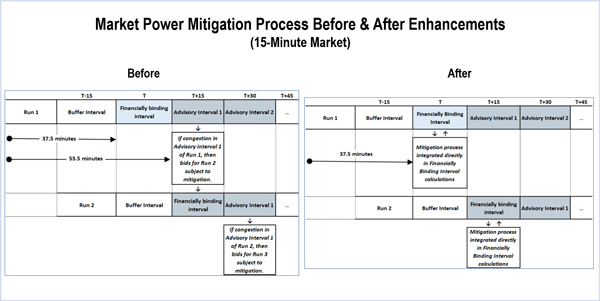By Robert Mullin
FERC has approved CAISO’s plan to fine-tune its procedure for preventing generators from exercising market power during local transmission constraints.
The provision allows the ISO to increase the frequency of its intra-hour “mitigation runs” designed to determine whether transmission congestion is temporarily providing certain generators with market power.
“We find that CAISO’s proposal will improve the accuracy and effectiveness of CAISO’s local market power mitigation process by addressing situations where CAISO currently under-mitigates in the real-time dispatch process,” the commission said in its Nov. 8 order (ER16-1983).
Under current practice, CAISO evaluates congestion patterns for “uncompetitive” transmission paths in an “advisory” and financially non-binding market run about 50 minutes before real-time procurement and dispatch.
“If load only can be served by dispatching resources owned by a small sub-set of ‘pivotal suppliers,’ then the CAISO assumes there is local market power and automatically imposes market power mitigation measures on resources that would benefit from the noncompetitive congestion,” the ISO explained in its June filing with FERC.
Those measures consist of applying the higher of a generator’s default energy bid or the ISO’s administratively determined competitive price, unless the market-based bid is lower than either number. Default bids can be based on a resource’s variable costs, a negotiated rate or a weighted average of LMPs set at the unit over the previous 90 days. Resources can rank their default bid preference from among the three options, subject to the ISO’s approval.
The ISO currently conducts a mitigation run for each 15-minute real-time unit commitment interval within an operating hour. Any mitigation triggered for that 15-minute interval applies to each of the five-minute dispatch intervals contained within — and also continues for the rest of the hour.
CAISO said its current measures assume that the conditions existing in the non-binding mitigation run will persist during the financially binding market run occurring 37 minutes ahead of the market interval. But changing conditions put the ISO at risk of either underestimating or overestimating the congestion.
“True congestion discrepancies frequently are caused by changes to inputs to the market optimization, as well as new information becoming available, in the time between conducting the mitigation and binding market runs,” the ISO said.
The solution approved by FERC attempts to prevent “under-mitigation,” which would expose load to excessive costs.
Under the new measure, the ISO will implement an additional mitigation run for each five-minute dispatch interval within a 15-minute real-time unit commitment interval.
The new run will be integrated into financially binding operations and allow the grid operator to factor in congestion not foreseen during the initial mitigation run. If necessary, it will be able to mitigate generator bids closer to the time of delivery.
“If any bid mitigation occurs, a second scheduling run is performed with these mitigated bids,” the ISO said. “A final pricing run is then performed to determine financially binding prices for the 15-minute interval.”
Once a bid has been mitigated for a five-minute increment, the mitigation remains in place for the balance of the 15-minute interval.
Any bid mitigation applied to a unit during the initial non-binding real-time unit commitment (RTUC) run will remain in place for the hourly interval regardless of whether a subsequent real-time dispatch (RTD) run shows a decrease in congestion within that hour.
“A unit that was mitigated for the RTUC but unmitigated for the RTD could be put in the untenable position of having to buy back its [15-minute market] schedule at a loss,” the ISO said.
“We agree with CAISO that improving the granularity of the mitigation process and improving the information that goes into the market runs will result in a more accurate representation of real-time system conditions that should enhance the overall measure of competitiveness of the market,” the commission said in approving the new procedure.
The commission denied a request by Pacific Gas and Electric that CAISO file a “reversion plan” in case the procedure results in “unforeseen” performance issues, or failed market runs require the ISO to rely on a fallback measure.
“Unlike the limited circumstances in which the commission has previously required or accepted the submittal of reversion plans, such as the launch of a new market where there was a risk of a significant operations failure, we find that such a risk has not been presented here,” the commission said.
The ISO’s local market power mitigation procedure goes into effect Jan. 30, 2017.




